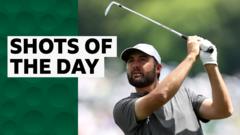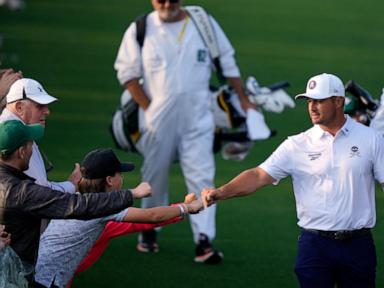
When Rory McIlroy holed a devilish chip for eagle at the second, igniting a sequence of six threes unparalleled in the history of the Masters, the usual decorum of an Augusta crowd evaporated. Everywhere you looked, there were corporate bros hugging each other, high-fiving, dashing to the nearest concession stand for refills of their six-dollars-a-pint Crow’s Nest lager. It was an atmosphere more befitting a Ryder Cup than the loftiest stage in sport. Such is the effect of watching golf’s purest talent in full free-wheeling mode, fuelled by nothing but adrenalin and the knowledge that he can produce feats of which others merely dream.
The gasps were audible, both in the galleries following McIlroy and in those watching the manual scoreboards updated elsewhere. 3-3-3-3-3-3: the start to his third round was without precedent in the tournament’s 91 years. So much for the theory about McIlroy feeling inhibited around this course, or disinclined to play his natural game for fear of failure. This was a day when he released the handbrake in spectacular style, staying true to his commitment to let the score come to him. A wise move, all told, given that his card belonged to the realm of fancy.
Take his tee shot at the first. A murmur of anticipation stirred the moment that McIlroy removed the fluffy St Bernard head cover from his driver, an early signal of his intent. The noise turned to disbelief when he launched the ball 371 yards, 56 further than anybody else had managed here all week. “BMW,” his friend Graeme McDowell once nicknamed him. “The ultimate driving machine.” Discretion tends to be the better part of valour on the opening hole, with a giant fairway bunker on the right awaiting the unwary. But McIlroy’s phenomenal distance ensures he pays no heed to the normal obstacles.
To think, he had been nursing an elbow injury only a few weeks before. You would hardly have known it from the ferocity with which he uncoiled himself into his drives: 366 yards at the second, 308 at the third, 342 at the fifth. This was an alpha taming of Augusta, an interpretation of “moving day” at its most literal. It was as if McIlroy wanted, at 35, to channel the fearless front-running of his early 20s, when he won both the 2011 US Open and 2012 USPGA by eight shots. The lesson of his youth is that once ahead, it is best to trust your instinct and turn on the afterburners.
Except the mental scar tissue that McIlroy has accumulated at the Masters means it is seldom so straightforward. As he learned from his infamous implosion 14 years ago, the slightest misjudgement can spark an unravelling. On that occasion, one errant drive at the 10th was all it took for the wheels to come off. This time, a faint push into the sand at the eighth threatened to derail him, consigning him to a six at a par-five he would have expected to birdie. His response, though, was one of admirable maturity. While Bryson DeChambeau and Scottie Scheffler both struggled to fire, McIlroy understood the virtue of patience, waiting until the 15th to conjure a potentially decisive flourish, arrowing a mid-iron to six ...





